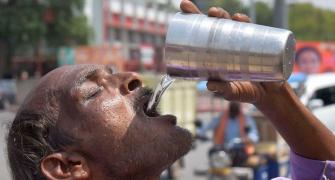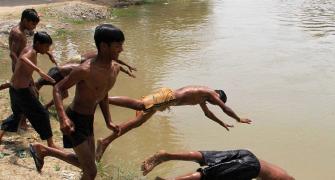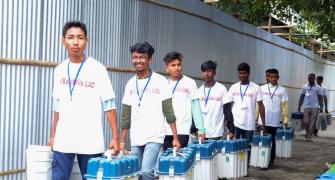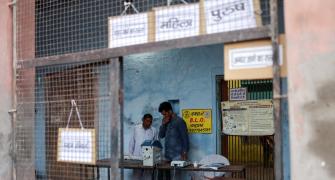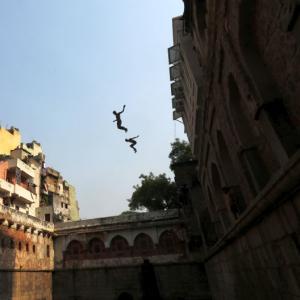Temperatures have soared to 50.3 degrees Celsius, but no deaths from the heat have been reported from Churu.
Ritwik Sharma finds out how Churu's citizens keep cool in the unbearable heat.

The unforgiving sun has set on Churu on the day the mercury rose to 50.3 degrees Celsius.
After a brief exposure outdoors contributed to an aching head, staying put in the air-conditioned hotel room and going to bed early appears to be a wise option. But an acquaintance, a native of India's hottest place, shows up and invites me to his cousin's wedding.
Soon I find myself at a colony next to the railway tracks, and realise that it's business as usual in this small city of Rajasthan -- the mind-numbing heat notwithstanding.
Friends and colleagues of the groom, who works in the fire department, tell me that the summer heat doesn't affect them. As if to prove a point, they take a swig of whisky before joining the baraat. At 8:30 pm, the temperature is a gentle 42 degrees.
A jeep with speakers at the back and a fellow working on a playlist on a laptop begins to blast out songs. The heavy beats and cacophonous pitch of the 'DJ sound' stir the baraatis into action.
The vehicle trundles towards the wedding venue close by, with men dancing along. Women in colourful saris, a handful of whom occasionally break into a dance, tail them.
The noise has drowned out conversation, and after nearly an hour among the crowd I sense a light wind on my back.
At close to 10 pm, the temperature sensor on the mobile phone suggests 39 degrees.
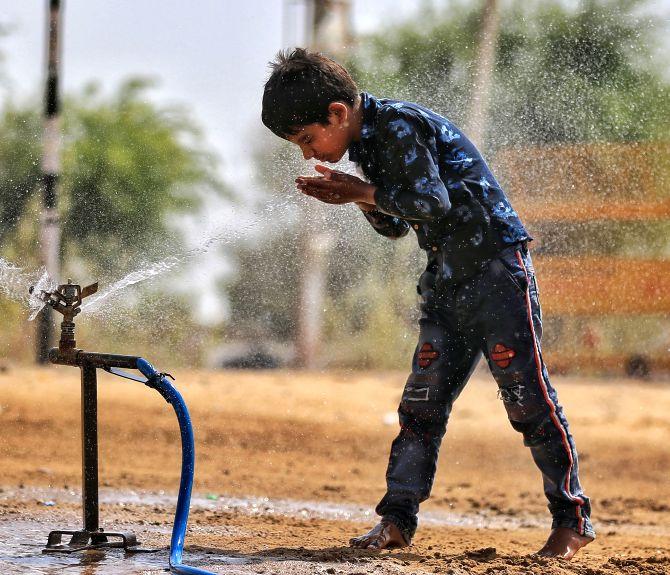
Kamla Devi, who runs a grocery store at her home in the colony, agrees that the heat is more severe this year. "But we have been living here, so we have become more tolerant of it. We stay at home mostly," she says.
The lack of outdoor activity is apparent in the afternoon. When we reached the city after a six-hour drive from Delhi earlier that day, there was little traffic. More than helmets, towels around the faces of two-wheeler riders in full sleeves were a common sight.
Even by the standards of Churu, a city of 120,000 people that is known as the gateway to the Thar Desert, this has been an exceptionally hot summer.
On June 2, it recorded 50.8 degrees Celsius -- an all-time high for a place that witnesses extreme weather conditions during winter, too.
Mohan Lal, a sugarcane seller, says he gets more customers when the weather is less extreme. "People don't venture out much now. They prefer to have dahi, lassi, chaach (buttermilk), cold drinks and watermelon."
The heat wave has claimed many lives in India this year. None of these casualties was from Churu, despite its extreme weather. This is partly because of the people's resilience and partly owing to the measures the administration has taken.
The district administration has directed hospitals to treat patients suffering from heat stroke as a result of loo (the dry, dusty summer wind from the west that blows over North India) as emergency cases.
It has advised Mahatma Gandhi National Rural Employment Guarantee Act workers to start early, at 6 am instead of 10 am, and return home by 2 pm.
Advisories ask people to stay indoors between noon and 3 pm, and also warn against making beasts of burden toil during these hours.
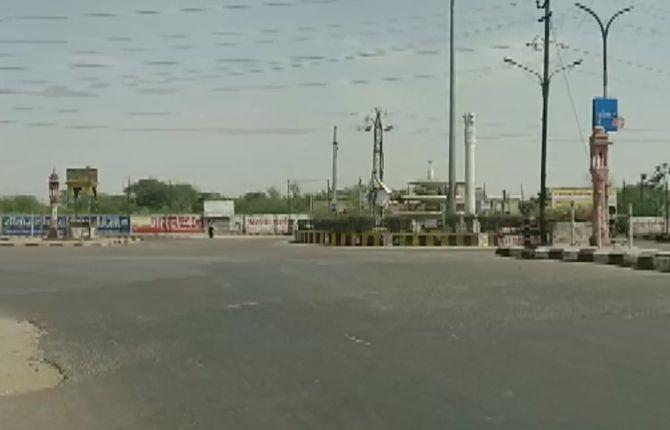
Sandesh Nayak, the district magistrate, says that unlike in cities like Jaipur, there is no major construction work in Churu. With little agricultural activity as well, people are able to exercise caution against the heat.
"People here have raabdi, which aids the enzymes allowing the body to adjust to the weather. Even Border Security Force jawans have it."
Raabdi is prepared by mixing the flour of bajra (pearl millet) and moth beans with chaach, to which water is added.
When the temperature soars, the gruel is kept out in the sun. The froth is separated from the fermented mix, which is then cooked and kept overnight.
Many, in rural areas especially, start the day with this drink mixed with chaach, cumin seeds and salt. Locals claim it's the best way to protect oneself from the loo. With its sour flavour, it is similar to an alcoholic drink that can induce sound sleep, they add.
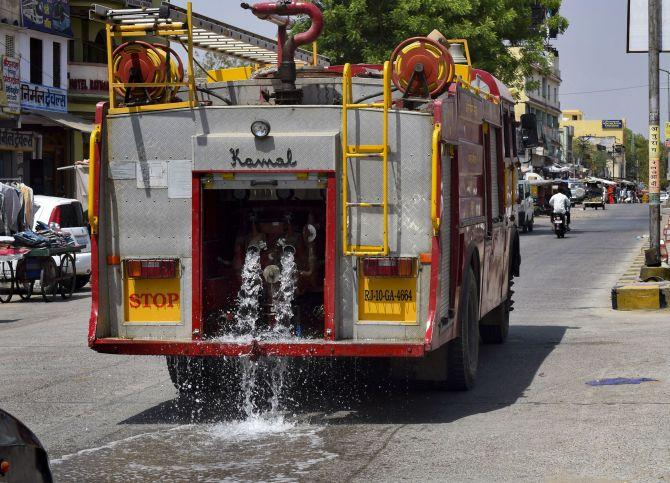
Om Prakash Choyal, an ayurvedic doctor, does get patients with complaints of vomiting, diarrhoea, pain in the limbs and heat stroke-like symptoms. "But people take precautions and regularly have buttermilk, a liquid diet and raabdi, which cool you," he says, adding that they also eat a lot of onion and aam panna, both of which help against the heat.
Churu gets a third of its water supply from the Indira Gandhi Canal, with groundwater sources contributing to the rest.
Due to the high salinity of groundwater and fluoride content, reverse osmosis (RO) water is in demand, especially in the city. An RO water supplier says he supplies 5,000 to 6,000 litres (Rs 20 per litre) daily, adding that there are around 80 RO plants.
Since the Indira Gandhi Canal closed for repairs from March-end to April, the administration has been monitoring water provisioning for the peak summer months.
Nayak says that except for a crisis in some interior areas, there is no shortage of drinking water in Churu.
The only infrastructural problem, he adds, is posed to the grid substations where power lines risk catching fire if the mercury shoots to 50 and above, as it has this year.
"So every hour, we have a power cut to ease pressure on the substations."
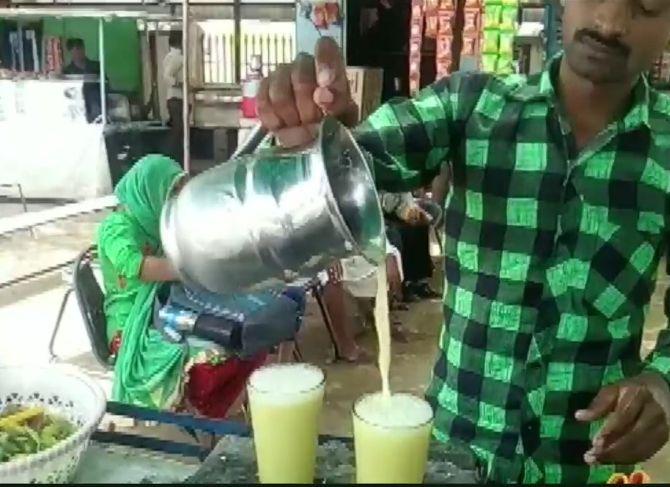
Churu's temperature has been rising over the years.
According to data from the meteorological department, in 2008, the highest temperature recorded here was 43 degrees. In 2017, it touched 46.7 degrees and last year it rose to 49.7 degrees. But, unlike previous years, there have been no intermittent dust storms or precipitation.
This has resulted in a long, uninterrupted spell of scorching heat.
The effects are showing on the sandy farm fields. The seeds of moong, moth beans and bajra sown a few weeks ago have dried up.
Rameshwar Prajapat, an advocate from Churu who distributes seeds to farmers, says these are low water-requirement crops. They will be sown twice over the next three months, and will yield results depending on the monsoon.
It is mid-day and vast tracts of farmlands, which are dotted with Rajasthan's state tree Khejri (Prosopis cineraria), are barren.
In a shady spot under a tree that bears the sangri (desert beans), a couple of young goatherds are tending to their flock.
Some of the 200-odd goats have their forelegs tied with ropes. The skittish animals -- one made a sly attempt to chew my shirt -- keep the goatherds on their toes, but it's worth the effort.
The goats are prized, as their milk is in great demand. On normal days, it is sold at Rs 20 to Rs 25 a litre, but during a swine flu outbreak earlier this year or dengue epidemics it can rocket to Rs 1,000 a litre.
Churu has low forest cover compared to other districts in the desert state. As a result, its barren lands heat up easily during the afternoon, says J B Khan, associate professor, botany, Government Lohia College, Churu.
"The soil particles are also comparatively minute here, so they heat up and also cool down quickly. And, the bowl-shaped topography of Churu (which is surrounded by shifting sand dunes) creates a micro-environment that is conducive for extreme weather conditions," he adds.
Back at the wedding, the guests have dinner early. Some stand in front of large coolers. One of the guests, a Narendra Modi lookalike, draws attention and gets approached for photos.
The wedding rituals are about to start and will continue till early morning. It's an appropriate time to get some serious work done in India's hottest town.


